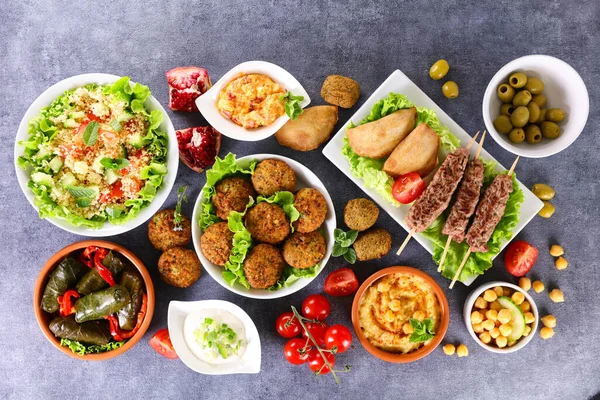Lebanese cuisine is a delightful mix of flavours, textures, and aromas that have been perfected over centuries. Known for its fresh ingredients, vibrant spices, and health benefits, Lebanese food is gaining popularity worldwide, including in the UK.
The Essence of Lebanese Cuisine
Lebanese food at the likes of https://shawarmahut.uk/ is a reflection of its diverse cultural history. The cuisine has been influenced by various civilizations, including the Phoenicians, Ottomans, and French. This rich tapestry of influences is evident in the variety of dishes and the use of spices.
Key Ingredients
At the heart of Lebanese cuisine are a few essential ingredients:
- Olive oil – Used generously in cooking and as a dressing.
- Garlic – Adds depth and aroma to many dishes.
- Lemon – Provides a fresh, tangy flavour.
- Herbs – Parsley and mint are staples.
- Spices – Cumin, coriander, cinnamon, and sumac are commonly used.
Must-Try Lebanese Dishes
Here are some dishes you shouldn’t miss:
Mezze: The Lebanese Tapas
Mezze is a selection of small dishes served as appetizers. They are perfect for sharing and offer a glimpse into the variety of Lebanese flavours.
Hummus
A creamy blend of chickpeas, tahini, lemon juice, and garlic, hummus is a beloved dip that pairs perfectly with warm pita bread.
Baba Ghanoush
This smoky aubergine dip, mixed with tahini, garlic, and lemon juice, is a favourite among vegetarians and meat-eaters alike.
Tabbouleh
A refreshing salad made with bulgur wheat, parsley, mint, tomatoes, and a lemon-olive oil dressing. Tabbouleh is light yet packed with flavour.
Kibbeh
Often considered the national dish of Lebanon, kibbeh consists of bulgur wheat, minced onions, and finely ground lean beef, lamb, or goat. It’s typically shaped into balls or patties and fried or baked.
Main Courses
Lebanese main dishes are hearty and satisfying, often featuring grilled meats, aromatic rice, and flavourful stews.
Shawarma
Thinly sliced marinated meat, usually beef or chicken, cooked on a rotating spit. It’s served in a flatbread with garlic sauce, pickles, and vegetables.
Kafta
Skewers of minced lamb or beef mixed with parsley, onions, and spices. Kafta can be grilled or baked and is often served with rice or wrapped in pita bread.
Manakish
Often referred to as Lebanese pizza, manakish is flatbread topped with za’atar (a blend of thyme, sumac, and sesame seeds), cheese, or minced meat.
Fattoush
A vibrant salad made with mixed greens, tomatoes, cucumbers, radishes, and fried pieces of pita bread, all tossed in a zesty lemon-sumac dressing.
Desserts
Lebanese desserts are a treat for the senses, combining sweet flavours with unique textures.
Baklava
Layers of phyllo pastry filled with chopped nuts and sweetened with honey or syrup. Baklava is rich, flaky, and utterly delicious.
Knafeh
A pastry made with shredded phyllo dough or semolina, soaked in sweet syrup and layered with cheese or cream. Knafeh is often enjoyed with a cup of strong Lebanese coffee.
The Flavours of Lebanon
The magic of Lebanese cuisine lies in its spices and herbs, which add depth and complexity to each dish.
Sumac
A reddish-purple spice with a tart, lemony flavour. Sumac is often sprinkled on salads, grilled meats, and dips for a tangy kick.
Za’atar
A blend of thyme, sesame seeds, and sumac. Za’atar is used as a seasoning for meats, vegetables, and breads, and is also mixed with olive oil for a simple dip.
Cardamom
With its warm, slightly sweet flavour, cardamom is used in both savoury and sweet dishes. It adds a distinctive aroma to Lebanese coffee and desserts.
Cumin and Coriander
These spices are often used together to season meats and stews, adding earthiness and warmth to the dishes.
Cooking Lebanese Food at Home
Bringing Lebanese flavours into your kitchen is easier than you might think. Here are a few tips to get you started:
- Stock Your Pantry – Keep essential ingredients like olive oil, garlic, lemon, parsley, mint, and spices on hand.
- Start Simple – Begin with basic recipes like hummus or tabbouleh. These dishes are easy to make and will help you get a feel for the flavours.
- Experiment with Spices – Don’t be afraid to use spices generously. They are key to achieving authentic Lebanese flavours.
- Cook in Batches – Many Lebanese dishes, such as stews and dips, can be made in large quantities and stored in the fridge or freezer for later use.
- Use Fresh Ingredients – Freshness is crucial in Lebanese cuisine. Whenever possible, use fresh vegetables, herbs, and high-quality meats.
Dining Out: Lebanese Restaurants in the UK
If you prefer dining out, the UK is home to a growing number of Lebanese restaurants that offer authentic and delicious dishes. Here are a few tips for enjoying Lebanese food at a restaurant:
- Order Mezze – Start your meal with a selection of mezze. It’s a great way to sample a variety of dishes and flavours.
- Ask for Recommendations – Don’t hesitate to ask the staff for their recommendations. They can guide you to the most popular and authentic dishes.
- Try the Specials – Many Lebanese restaurants offer daily specials that highlight seasonal ingredients and traditional recipes.
Final Thoughts
Lebanese cuisine is a celebration of fresh ingredients, bold flavours, and culinary traditions that have stood the test of time. Whether you’re cooking at home or dining out, exploring Lebanese food is a journey worth taking.




